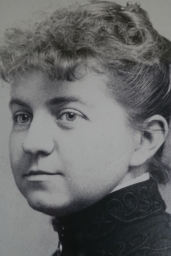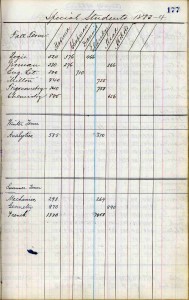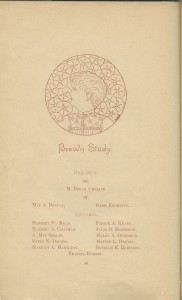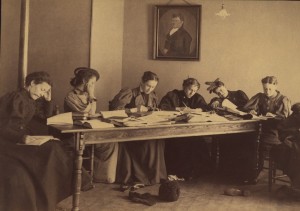In the Herstory of the first women on campus, May Belle Chellis receives the most attention. She was the first female to graduate from Middlebury College in the class of 1886 after attending the school for 3 years. Not only did she graduate in a
short period of time, she was the top of her class, controversially receiving the coveted Greek prize of valedictorian. Records from the college grade book show she entered the school in the summer of 1883,
technically not a full time student. That next fall semester she was joined by two more females, May Anna Bolton and Louise (Daisy) Hagar Edgerton. All three took on full class loads. While the reason behind their acceptance and acknowledgement in the college community from an administrative position was a miscommunication on the part of the Board of Trustees and the president, Rev. Cyrus Hamlin, the three women joined the class of ’87. After two years with the class, May Belle Chellis began studying with the class of ’86. From being the top of ’87, she seamlessly transitioned to the top of the class of ’86, graduating that year. As a leader of the Brown Study, a room which was given to the women to use while they were on campus to study in, May Belle Chellis was a forerunner for women on campus.
While it is important that May Belle Chellis receive recognition and praise, the stories of the other women present on campus are often lost and hidden behind the achievements of the first. While there were only two other women taking a full load of classes, records show there were a lot more female special students circulating and affiliated with the college. During the years of ’85, ’86 and ’87, there were a documented total of 7 female special students. While only some are mentioned in the official college grade book, they are documented in the college alumni catalog. Why they were not mentioned in the grade book is an unanswered question however their presence was noted. There were multiple female students not only taking classes but affiliated with the college. In the Kaleidoscope of 1887, a college year book produced by the junior class of 1887, there was not only a piece written mentioning the first co-educational environment but a tribute to the Brown Study and the women who were affiliated with the space. The inclusion of such a page in a student run publication shows the degree to which the men were acknowledging the females on campus. The majority of the females listed under “Special” were all special students at the time. There is no documentation on Estelle E. Robinson, Helen A. Goodrich, nor Mattie L. Daunis. Although they were not taking classes, they were intellectually engaged on campus along side those females who were technically affiliated with the college.
While there was much debate as to whether or not the women should be given the same opportunity as the men as Hamlin had previously stated, the men in the class of ’87 wrote about their pride and adoration for the female members of the class. At the begging of the Kaleidoscope, there is a brief history of each of the classes. While there is no mention of May Belle Chellis in the class of ’86, the class of ’87 does mention their fellow female students in both the beginning and in the closing statement.
“For us was reserved the pleasant task of initiating the first co-eds ever admitted here to the mysteries of college life, and sacredly have the fair priestesses guarded the holy fires on the altar of knowledge… In closing, it is fitting that we should say that our sisters in the class have halved out sorrows, rejoiced in our victories and doubled out joys. What could they do more?”
The Kaleidoscope was a year book produced by the junior class and was filled with their sense of humor. Throughout the book jokes pop out of the narratives hiding in the foot notes. However projected this may be, there seems to be no sarcasm in their statements about their fellow classmates. On the contrary, they commend their classmates as
respectable additions to the college environment. However few in fully documented numbers, women came onto campus and into the classroom not blending in, for how could they. They fought for a room of their own, the Brown Study, and received it. There they had a community of other women to support them in their educational growth and acceptance into a sphere that had previously been dominated by men.



